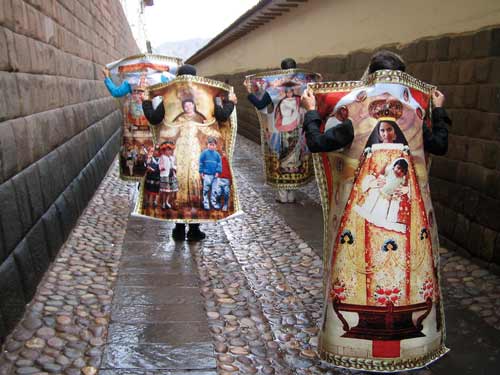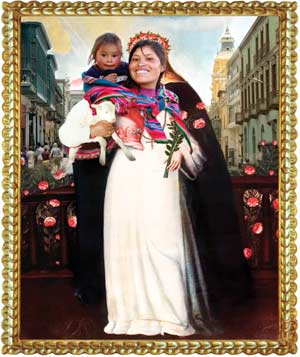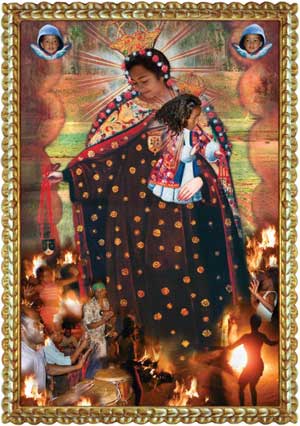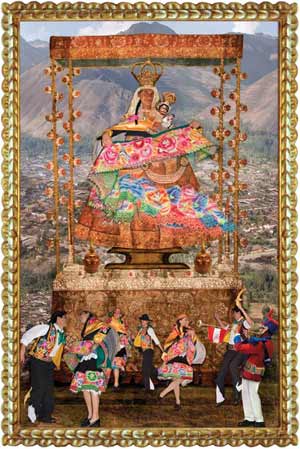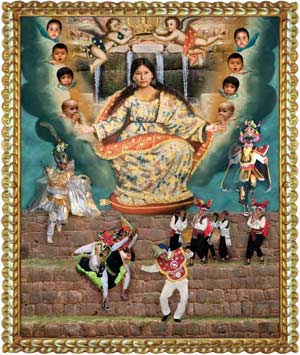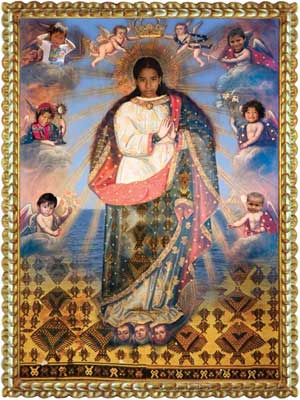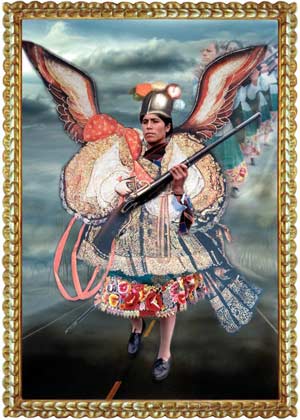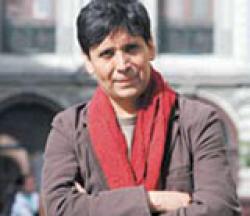The Virgins parade through the city. On Cusco sidewalks, in parks and plazas, their faces brush against businessmen, beggars, girls in plaid skirts with schoolbags slung over their shoulders. Someone may look up and see Our Lady of Cocharcas enthroned above the curb or ducking down a cobblestone alleyway, baroque wings flapping. Saint Rose of Lima may bump into a woman carrying groceries as the streetlight changes.
Spanish colonial art is famous for its Virgins. Peruvian-born artist Ana de Orbegoso wanted to create a series of images that would both pay tribute to and critique that tradition. She appropriated Spanish images of the saints and Virgins, and then used modern photographic techniques to replace the docile, European faces with the faces of the Peruvian women of today. Her giclée prints superimpose the new over the old, the empowered over the objectified, drawing attention to both.
But, instead of confining the works in art galleries, de Orbegoso wanted to make the Virgins a part of the modern landscape—Urban Virgins. She turned copies of each collage into a costume for her accomplices to wear on a walking tour of Cusco. Picture an unlucky employee lumbering between sandwich boards, and you’ll have some idea of the scene, but instead of advertisements they’re walking works of art.
By this juxtaposition of colonial imagery with city environments, de Orbegoso hoped to show that these icons were never part of the world they inhabited. Instead, they embodied, and were used to impose, European values and standards on the conquered Americas. According to de Orbegoso, the colonial Virgin was propaganda, promoting “the ideals to which native women were supposed to strive—purity, benevolence, and compliance.” Like the Holy Mother, they should be blank, silent, and, preferably, as white as possible.
Imperial conquest is more than physical subjugation; it colonizes bodies, minds, and—most dangerously—imaginations. Along with muskets and disease, the Spanish brought their language, their religion, and their culture. Colonized artists, de Orbegoso says, were forced to reject their native art forms in order to mimic the Spanish style. Express yourself, if you must, the Spanish said, but our way, not yours. In Urban Virgins, de Orbegoso rejects the oppressive legacy of colonial vision by replacing the anonymous saints with photographs of living women. In place of the ideal, she offers the real—a new kind of icon.
While the colonial Virgin was a static representation of a complex reality, de Orbegoso’s Virgins embody the intricacies of South America, of Peru, of Cusco, which she calls a “fusion of European and indigenous cultures . . . where colonial structures superimpose Inca walls, and Christian beliefs coexist with Andean spirituality.” The Virgins are surrounded by trappings of the old and new, symbols of prosperity, poverty, celebration, and tragedy. At their feet: flames and flowers, dancers, begging children, escaped slaves.
In the suite presented here, de Orbegoso’s prints are paired with persona poems by Odi Gonzales. Gonzales was born and raised in Cusco; before he met de Orbegoso, he had published a book of poems, La escuela de Cusco (The Cusco School), in the personae of the anonymous Indian painters who worked depicting Christian saints, Virgins, and archangels in Peru’s highland monasteries in the seventeenth century. They were introduced by a mutual friend, and Ana asked if Odi would consider writing a poem to each of her images. “When I saw the first collages,” Gonzales says, “I was truly astonished. Ana’s work was so stimulating that I just started writing.”
And, appropriately, he began writing in Quechua (the official language of the Inca Empire), which he had grown up speaking. [Editor’s note: the poems are presented below in their original Quechua, as well as translated into English and Spanish.] “Like Ana, I am trying to make an intercultural statement by mixing languages, mixing cultures,” says Gonzales. “Quechua is an ancient oral language, in which you have to translate ideas, concepts from this culture into another. That is hard, but I always have the ancient heritage of my Quechua culture with me. I feel in Quechua.” The resulting poems both explicate and interpret the images, adding extra layers to each collage. The once-anonymous Virgins tell their own stories; they take back from colonial art the power to represent, interpret, and prophesy. Saint Rose of Lima, the first saint born to the Americas, announces, “I am Rosa. Florist of Five Corners. Gate of Flowers . . . Cusco will flower.”
In Gonzales’s poems, the Virgins embrace their role in the modern world in opposition to an idealistic Heaven. Here, Rosa says, is “an intricate tapestry of landscapes.” The Virgin of the North, her arms spread in blessing, says she does not need “the vaulted niche in the choral balcony of a cathedral . . . the naves of the old haven of a parochial temple / My altar—like a Bedouin tent—stands up in the desert / My watery kingdom sprouts in the meadows of sandy rivers.”
These are democratized Virgins. Occasionally, they lament the loss of some ornate enchantment they might have had as impervious ideals. The Immaculate Virgin, left like an ordinary woman “at the corner of Procuradores and Comercio streets,” asks “where are my believers, the followers of my sacred tours?” She is stranded on the curb: “Cusco. Plaza de Armas, 2 a.m. / Heavy trucks go back and forth.”
The Virgin of Mercy justifies this shift from the ideal to the real. The art of the colonial era offered the Americas “fat little angels carrying banners” and meek white women—art that was lying to itself and its audience. The collaboration of de Orbegoso and Gonzales, by contrast, honors the genuine flesh-and-blood women of Peru. It recognizes the real “little martyrs of Almudena temple,” the “street-working children,” the empowered and the needy. Colonial art celebrated “seraphim playing lute[,] . . . misty distances” instead of meaning, but these Virgins offer a better kind of Mercy—the love of what exists, the worship of what we are—art in action, women in the world.
—Honor Jones
My firm flesh, profane. Young and supple, abundant half-breed
bringing health to the poor
I am not Magdalena, Hemorroisa, the Samaritan,
the Adulteress
I am not the Moreneta, the virgin blackened by the fume of the candles
of the wild believers
I am Rosa. Florist of Five Corners. Gate of flowers.
Quinoa patch. Unwed provincial mother. I say:
Lima will perish, Cusco will flower
My cape waves. My cape fits my young mare waist. In my fingers the ring,
the palm of martyrdom
In my back-cradle my baby is not the Child-Virgin weaving
Not the Child of the Thorns. Or is it?
Is it Satuco, Santusa, Julico, a portrait of his father
that kicks and cries: a nipple
Mis carnaciones firmes, profanas. Carnaciones de terneja, de mestiza abundosa,
gorda como para pobre
No soy la Magdalena, la Hemorroisa, la Samaritana
la Adúltera
No soy la Moreneta, la virgen renegrida por el humo de las velas
de los feligreses contumaces
Yo soy Rosa. Florista de 5 esquinas. Portal de flores
Campo de quinua. Madre soltera provinciana. Digo:
Lima perecerá, Cusco florecerá
Mi túnica flamea. Mi túnica ciñe mi alzada de potranca. En mis dedos la sortija,
la palma del martirio
En mi espalda-cuna mi wawa no es la Virgen-niña hilando
No el Niño de la Espina. ¿O sí?.
Es el Satuco, la Santusa, el Julico retrato de su padre
que patea y clama: teta.
Aychaykunapas p’utiy p’utiy. Sipas wachachaq aychan hina,
wira wira waqchapaq hina
Manan Magdalenachu kani, Emorroisapas
manataqmi Samaritanapas, icha Pantaq Warmipas. Manan chay
velak yanayasqan Moreneta mamachachu kani. Rosan noqaqa kani.
Pisqa k’uchupi t’ika qhatuyoq. T’ika qhata. Kinua pampa. Wawasapa
mana qhariyoq llaqtamasin kani. Hinatan nini:
Liman ñak’arinqa, Qosqon t’ikarinqa
Kusmay phalalayan. Kusmaymi uywa sayayniyta mat’ipayan. Makiypi
sortihay, muchuy chonta ima.
Wasay q’epinapi wawachay
manan puskaq warma qollanachu. Manataqmi kiska chakichayuq erqey
uchuy taytachachu ¿Hinachu manachu?
Satukuchan payqa, Santusachan, taytan uya
Julikuchan payqa, waqaych’uru, ñuñu puchu erqe
Today, Tuesday the first. Day of San Gerardo, patron saint of tailors
and dressmakers
Moving festival of Maria Santisima of Transit
there are no ukukus, qhapaq qollas, teralas, saqras, or scissor
dancers
No troupes for the Pillpinto nation
Today cimarron fugitives dance for me. Stamping in the sacred salt flats
an intricate tapestry of landscapes
My embroidered shawl of flowers,
the anonymous artisan of Pampachiri?
The crown of roses and the pair of sweet cherubs
are the adornments for the fiesta
of my daughter’s birthday
Hoy, martes a primero. Día de San Gerardo, patrono de los sastres y
costureras
Fiesta móvil de María Santísima del Tránsito
no hay ukukus, qhapaq qollas, teralas, saqras ni danzantes
de tijeras
No cuadrillas de la nación Pillpinto
Hoy me danzan cimarrones. Angeles prietos
en arrobamiento místico. Zapateo en el salar votivo
una complicada composición de fondos
Mi manto de tupido brocateado
¿el anónimo de Pampachiri?
La corona de rosas y la pareja de amorcillos
son las galas por la fiesta
de cumpleaños de mi hija
Killa qallariy martes p’unchay, San Herardoq sumaq p‘unchaynin
tukuy siraqkunaq Paypa marq’asqan. Kunan p’unchay
Qollanan Marya Santisima del Transito muyuq raymin
mana ukukullapas kanchu, qhapaq qollapas, teralapas, saqrakunapas
manataqmi tihiras tusuqkunapas kanllataqchu
mana Pillpintu suyumanta dansaqkunapas
Kunanqa tusupaywan yananiraq runakunan. Ch’illu k’illki
sumaq tusuqkuna, muspha muspha t’aqyatayaqkuna
kachipanpa laqhayasqa karu allpakuna qhepaypi
Sumaq t’ikallisqa p’istunay
¿Panpachirimantachu kanman icha?
Imarayku t’ika pilluy, chay sumaqyasqa k’illkichakunapas kaypi?
imaraykus kaypi kanku?
wawachaypa wata fistachan raykulla kanku
My skirt goes around eight times. Region: Yunga-Altiplano
My Castilian center skirt, embroidered by the linen weavers of Lucre
honoring my attire
My hair is the braid of a young woman from Langui
The town in the background could be Pisac as seen from the Taray over-view
the Callejon de Huaylas from the Cuesta de Animas. Switchbacks.
on this hill the Virgin’s bearers gave up
“Take me to the chapel of the Hospital of the Natives,” I said
but they left me here like a Tired Boulder
Mondays—the cattle fair—venders visit me
Mi pollera tiene 8 vueltas. Región: Yunga-Altiplano
Mi fondo, mi centro de castilla bordado por los tocuyeros de Lucre
honra mi vestuario
Mi cabellera son las trenzas de una muchacha de Langui
La población que se ve al fondo puede ser Pisac desde el mirador de Taray
el Callejón de Huaylas desde la Cuesta de las Animas. Cimbral.
en esta colina desistió la cuadrilla de cargadores de la Virgen
“Llévenme a la capilla del Hospital de Naturales” dije
y aquí me dejaron como a la Piedra Cansada
Los lunes—feria del ganado—me visitan los minoristas
Yunka qolla suyukunamanta pusaq muyuq phalikawan p’achakuni
Ukhu phalikay, kastilla phalikay, tukuy p’achay
Lukre siray kamayoq sirasqan
Chukchaytaqmi Langui wachachaq sinp’an
Qhepaypi karu wasikuna paqta kanman P’isaq llaqta, Taraymanta qhawalayasqa
otaq Waylas K’ikllu kanman Nuna Wayq’omanta rikukuq. Q’enqo
Kay qhata patapin lluy Mamacha q’epeqkuna samapusqaku
“Onqoqkunaq hanpi wasi kapillanman apawaychis” nirqani
paykuna ichaqa saqeywanku kay qhatapi, Rumi Sayk’usqata hina
Uywa qhatu p’unchaypi ichaqa pisi t’aqayoq runa watukamanku
My morning shower at the gate of the red birds
The mouthwash
The diligent cleaning of the intimate parts
—immersion in the Tambomachay springs—
are my ceremonies of eternal cleansing:
at age ten
I was taken forcefully at the urinal of the princess
Calf of the thermal springs
Little children sick with fear swirl around me
they look for my maternal breast
the smell of milk?
At the gate of thunder
appear those who
call back the scared spirits
Mi baño matinal en el andén de las aves coloradas
El enjuague bucal
El aseo diligente de la parte de las vergüenzas
—sumersión en los puquios de Tambomachay—
son mis ceremonias de lavado, de ablución perpetua:
a los 10
fui forzada en el mingitorio de las princesas
Terneja de las aguas termales
Parvulitos con mal de susto me asedian
me buscan el seno materno
¿olor a leche?
En la terraza de los truenos
cunden los llamadores de ánimo
Pillkupata raqaypi tutamanta armayniy
simi moqch’ikuyniy
pkakay ukhu sumaq ununayniy ima
—Tanpumach’ay pukyupi challpuykuy—
noqapaq kan ch’uyayckakuy, mana tukukuq mayllina saminchakuy:
chunka watachaypi
ñust’a hisp’ana uraypi kunpawanku
Pukyu unu wachacha
mancharisqa erqekuna qatipayawanku
k’iki ñuñuyta masqhaspa taripawanku
¿ñukñu q’apay?
Q’aqya pata k’ikllukunapi
manchali nuna waqyapakuqkuna waqyaykachanku
Cattle brander, tamer, salt dealer
butcher, pork castrator, bird breeder
hidden-treasure hunter, food seller
these are the jobs in God’s kingdom
For us
the sea is our field
Weaned with cetacean bile, my little brothers,
a prodigious family, and I
the firstborn daughter
wait the return of my father the fisherman
who went to sea
three days ago
Marcador de ganados, amansador, rescatista de sal,
matancero, capador de cerdos, pajarero,
buscador de tapados, vivandera. . .
son los oficios en el reino de Dios
Para nosotros
el mar es nuestra chacra
Destetados con hiel de cetáceo, mis hermanitos
familia numerosa, y yo
la primogénita
aguardamos el retorno de mi padre pescador
que se hizo a la mar
hace tres días
Uywa tuyruq, uywa atipaq, kachi qhatuq
ñak’aq, khuchi kapador, pichinku mirachiq
qori maskhapakuq, chupi qhatu…
chayllan kay Taytanchispa suyunkunapi tukuy llank’ay
Noqaykupaq ichaqa
chakraykun hatun qocha
Challwakunaq hayaqenwan hanuk’asqa
turachaykuna, khullu khullulla, noqawan ima
phiwi ususi
suyapakuyku kaypi challwaq taytay kutimunanta
kinsa p’unchayña haykun lamarqochaman
manaraq kutimunchu
Although I am not from the highlands
fissures, corners, watersheds, ravines
I have the pride, the erect neck
of the llama herds, first ladies
ladies crossing crevices and depressions
I do not have the vaulted niche in the choral balcony of a cathedral
in the naves of the old haven of a parochial temple
My altar—like a Bedouin tent—stands up
in the desert
My watery kingdom sprouts in the meadows of sandy rivers
The subtle bow of my father—northern rider—
upholds the heritage of the northern kingdoms:
my blood
Aunque no soy de las cuestas y laderas de la serranía
abras, rinconadas, cuencas, quebradas
tengo la altivez, el cuello erguido
de las tropillas de llamas primeras damas
ladies pasando las angosturas y hoyadas
No tengo hornacina en la capilla del trascoro de una catedral
en las naves de la bóveda vaída de un templo parroquial
Mi altar—como la tienda de los beduinos—se alza
en el desierto
En los remansos de los ríos de arena brota mi reino acuoso
La sutil venia de mi padre –un chalán-
guarda la estirpe de los señoríos del norte:
mi sangre
Maski wayq’okunapi, urin qhatakunapi mana paqarinay kaqtinpas
willk’ikunapi, k’ikllu k’uchukunapi, lluy p’ukru ukhukunapi
mana tiyaqtiypas, ichaqa noqa
sayaq kunka apusonqo kani
suri llamakuna hina, sumaq sipaskuna
k’ikllukuna chinpaykachaq sumaq ñust’akuna
Manan apu sunturniy kanchu takiq kapilla qhepapipas
manataqmi manqos raqay wasi qatapipas
Antharay—purun panpa runaq ch’ukllan hina—kan
altarniy sayarin aqo qhatapi
P‘onqo aqomayukunapi phutun unuchasqa suyuy
Chalan taytaypa sumaq k’umuyayninmi kan
chincha suyu hatun runakunaq apulayan:
paykunan yawarniy kanku
Golden dalmatic, my tight clothing
reveals the body that it covers,
designer of the Florentine school?
The burning cinnamon color of my face
was plastered with weasel bile,
the master of Pitumarca?
The troupe of children,
fat little angels carrying banners?
seraphims playing lute, trumpet-playing angels?
not misty distances alone
The little martyrs of Almudena temple
street-working children
Clothing of angular folds, flying capes
cave ornamentation
Paracas shawl?
The author’s signature is a bird hidden
in the layers of varnish
Dalmática dorada, mi ajustada prenda
trasciende la anatomía que cubre
¿escuela florentina?
El encendido encarne de mi tez canela
fue enlucido con hiel de comadreja
¿el maestro de Pitumarca?
La cuadrilla de infantes
¿gordos angelillos desnudos portando cartelas?
¿serafines tocando laúdes, ángeles trompeteros?
no lejanías brumosas
Los pequeños mártires del templo de la Almudena
niños-trabajadores de la calle
Vestimenta de pliegues quebrados, capa volante
ornamentación de grutescos
¿manto Paracas?
La firma del autor es un gorrión varado
en las capas de barnices
Kay t’eqe p’achay, qorinchasqa phulluy
sumaq ukhuykunata riqhurichin
¿Florentina yachay wasimantachu kanman icha?
Uyay aychapas pukay panty yawrarishian
maskipas unkakaq hayaqenwan llusisqa
¿Pitumarkamanta llunch’iqchu kanman icha?
¿Kay tawqa chikuchakunari?
t’ika hap’ilayaq k’illki oqochukunachu kankuman
¿waqra phukuq serafinkunachu, arpa maywiqkunachu?
mana karunchasqa phuyupas kanchu
Almudena kapilla muchuy waqcha warmachakunan kanku
hawapi llank’aq erqechakuna
Taparasqa sumaq p’achay, phalalayaq llaqollay
tukuypas phallchakunawan t’ikallisqa
¿Paraqas p’istunachu kanman icha?
Llinp’iqpa sutinpi sayan huk pichitanka
llinphi ukhupi chinkasqa
I am not a scarecrow of the wheat fields, nor of my flowering potato patches
a Caracoto troupe dancer?
Since the death of my husband, of my beheaded children
slaughtered like sheep / massacre of the innocent saints
I became the head of the resistance
in the war zone
I fight against murderers from both sides
Chariots of fire fly around me. My decimated battalions
boil in my head. Wandering souls
My march ends in humble cemeteries
tombs where I buried my dead. It is there I weep
and clean my musket
No soy espantapájaros de los trigales, de mis papales en flor
¿danzante de las pandillas de Caracoto?
A la muerte de mi marido, de mis hijos degollados
como carneros / matanza de los santos inocentes
me hice cabecilla del grupo de ronderas
de la zona de emergencia
Lucho contra los matarifes de ambos bandos
Carruajes de fuego me sobrevuelan. Mis batallones diezmados
bullen en mi cabeza. Almas en pena
Mi marcha termina en humildes camposantos
fosas donde enterré a mis muertos. Allí sollozo
y limpio mi arcabuz
Manan t’ikariq papa ukhupi chakra manchachichu kani
¿Karaqotomanta tusuq q’achurichu kayman icha?
Qosay wañuqtin, chita hina ñak’asqa
llapan wawaykuna tukukuqtin / mana huchayoq sipinakuy
pusaq awqa madrina tukupuni, tukuy rikuq
manchay manchay suyukunapi
Tukuy ñak’aqkunapaqmi phiña kani, llapanwan tupani
Nina wantunakuna phalalayawan. Ñak’arisqa wallaykuna
umayman muyumun. Llaki nunakuna
Sapa p’unchay puriyniy ayapanpakunapi tukukun
ayaykunata panpaspa p’ukru ukhukunapi
Chaypin waqapakuni, walqanqayta allinchani
Cusco. Plaza de Armas, 2 a.m.
Heavy trucks go back and forth in my memory. Via Crucis.
Where are my believers, the followers of my sacred tours
at midnight? Where are the backpackers and the VIP tourists?
Brichera, Andean lover. Sensual rider in praying posture
Klaus
that huge Aryan banner no longer waves inside me
And what of the Nordic Brotherhood
of the Holy Drinkers of Plaza Regocijo?
And the Yauri herders? And the Quiquijana potters?
And the United Union of Silversmiths and the Guilders of San Blas? Who knows?
They have put me here, on my platform,
at the corner of Procuradores and Comercio streets. Not even
the fanatic widows who call me the Beauty of the Cathedral ask for me.
My faithful followers, my parade is gone. Are they false witnesses, taking refuge
at the Ukukus bar? Do they drink double inka shots in the Kamikaze?
Do they start flying at Mile Zero, in the whorehouse of Santutis?
The kids at my feet offer punch and cigarettes
Cusco. Plaza de Armas, 2.a.m.
Pesados camiones zigzagean en mi memoria. Vía Crucis.
¿Dónde están mis fieles, mis seguidores en mis recorridos procesionales
de medianoche? ¿Dónde mochileros y turistas VIP?
Brichera, andean lover. Jinetera en actitud orante
Klaus
ese enorme pendón ario ya no flamea dentro de mí
¿Y la Hermandad nórdica
de los Santos Bebedores de la Plaza Regocijo?
¿Y los troperos de Yauri? ¿Los olleros de Quiquijana?
¿Y el Gremio Conjunto de Plateros y Doradores de San Blas? Nonada
Me han plantado aquí, en mis andas,
en la esquina de Procuradores y Portal Comercio. Ni siquiera
claman por mí las beatorras que me llaman La Linda de la Catedral
Mis fieles, mi comparsa ida. ¿Perjuran acantonados
en la barra del Ukukus pub bar? Beben Inka’s shoot doble en el Kamikase
Alzan vuelo en Kilometro Cero, en Santutis?
Los párvulos a mis pies, ofrecen ponche y cigarrillos
Waqaypata Qosqo llaqta. Pacha illariy.
Llasan llasan kamiyunkuna umayman muyumun. Muchuy ñan.
¿Maytaq lluy qatichupaykunari? ¿Maypin kuskatuta layma puriqmasiykuna?
¿Maypitaq chay p’aqoyusqa wasa q’epikunari? ¿Maypi qolqeyoq puriqkuna?
Panpa warmi. Pantaq sipas. Qonqorchaki wachoq qoya
Klaws
chay hatun ario unancha manaña phalalayanchu ukhuykunapi. ¿Maypitaq
kunanri, chay Kusipatapi sumaq nordiko wayqepura ukyaqkuna? ¿Maypi
Yawri maqt’akuna? ¿May Kikihana manka llut’aqkuna?
¿Chay Sanblasmanta qori, qolqe takay kamayoqkuna, maypin? Yanqa.
Kaypin saqeywanku, kikin wantunay patapi
Prokuradores, Portal Komersio k’ikllupi. Manan tapuykunkuchu noqamanta
ch’ayña payallapas, chay qhasqo taka Munay uya Mamacha sutiyaqniykunapas
Qatipayaqniy qharikuna, orqo uywaykuna ripunku. Ichapas
ñakaywashanku Ukukus ch’akipana wasipi? Icha Kamikasepichu
hayt’apakuq Inka aqhata upiyashanku?
Ichachu musphayashanku Kilometro Seropi, Santutispi?
Chakiy patapi chikuchakuna poncheta, sayrita qhatukunku


